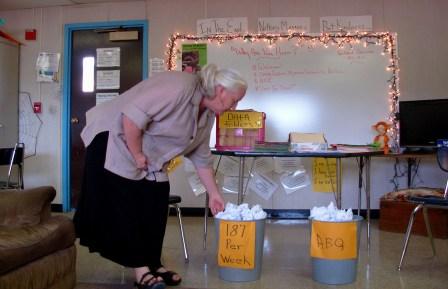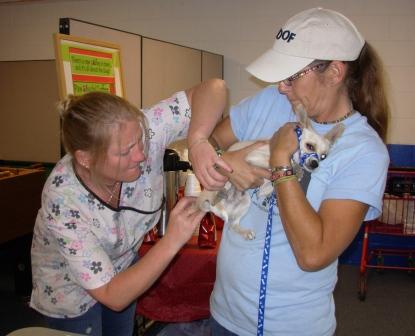Teaching Kids How Empathy Begins With Animals

Truman Middle School teacher Peggy Lynch-Hill does a demonstration in her classes of how many animals are euthanized, or “thrown away,” each week at the Albuquerque shelter, where she empties the trash cans on the floor. “The kids react to the number,” she says.
The idea of teaching compassion in school is gaining interest because of growing alarm over bullying—Washington state’s Compassionate Schools initiative is being held up as a model nationwide. And while most of these programs do not extend that teaching to animals, humane societies are jumping in with their own programs. The San Francisco SPCA, for example, has reached thousands of schoolchildren with a curriculum that includes animal behavior and care. A multi-agency project in Washington, D.C., is promoting humane education with classes in pet care, the importance of spay/neuter, anti-cruelty, and awareness of wildlife.
Here in the Rio Grande Valley, we have Corrales resident Peggy Lynch-Hill, a passionate advocate for humane education in the Albuquerque Public Schools. Winner of a 2011 Milagro Award from Animal Protection of New Mexico, Lynch-Hill created a humane education curriculum for her classroom at Truman Middle School on the West Mesa, the largest middle school in the state. In a ceremony in October, she was recognized for her innovative, holistic approach to fostering an awareness of compassionate values and how to translate them into action. Lynch-Hill has taught school for about 25 years, the last six as a teacher of the gifted. The Bosque Beast sat down with her recently to learn about her philosophy and approach.
What she teaches her classroom of gifted children: My seminar is problem-based, hands-on learning for kids who are gifted in creativity, problem-solving, and critical thinking. It’s really important for gifted children to spend time with their intellectual peers. But even more important is their emotional lives, because the gifted have their own set of issues.
The curriculum is based on humane education and social awareness. We discuss and debate how to better understand ourselves and others. how do we teach them to be better human beings and make positive change? Teachers know best the connections between how we treat animals and people. When you talk to students about being empathetic and kind, it affects them on all levels.
The spay/neuter campaign: The campaign is schoolwide and going full force this year. We gave a list of free and low-cost spay/neuter to 1,300 kids, because usually it’s a money thing. So we need to educate them about where they can go. If they have that information, it makes them into advocates. And it is having an effect.
I really believe we have to have more truth-telling about the problem of overpopulation of animals in this city. I had the shelter people present no-holds-barred photos of the euthanasia room, the bucket of needles (one per animal), the curtained rooms (“do you think the animals know what is happening in there?”), then the barrels of dead animals going to the landfill, just one week’s worth. We do a demo with these garbage cans, where every piece of paper represents the animals euthanized every week because of overpopulation. Then we throw them all over the room—and kids react to the number. Because it’s like they’re trash.
Some kids tell me they don’t want to neuter their dog. We need to counter the perception that unneutered males make better guard dogs. There’s also money-making, where people think they can sell the puppies or kittens. I ask them, when you’re sitting there by the side of the road with your kittens or puppies, how do you know the people who buy them will spay/neuter? The kids tell me they often end up giving a lot of the animals away.
On vegetarianism: Kids have a lot of good questions. They’ll say, ‘But I like steak.” That’s fine— but don’t we have a responsibility to treat the animals we eat with respect and kindness? We eat eggs and meat, but it’s our responsibility to treat those animals humanely. We watch a lot of videos on factory farming and talk about the realities. We had a discussion last year about the tainted eggs. I try to get them to see the links between tainted eggs and our treatment of animals, to see that we are all connected and that it’s a big win-win if everyone treats everyone and everything with kindness and respect.
On representing “the other side”: I do try to present it. But I find a lot of kids have not had any discussion at all about these things; they don’t think of food as being a living, breathing thing. If you’re in a family situation that’s just surviving, it’s all they can do to get their kids to school. There’s not a lot of time for interaction or discussion about what’s right and wrong. This is a Title 1 school—nearly all the kids are on free or reduced lunch. But we teach that you don’t have to have money to do the right thing. Like if you see abuse, call 311; you don’t even have to give your name. The worst thing is to turn a blind eye.
I ask how many of them are responsible for feeding and watering their dog before school, and then how many have forgotten sometimes. I get them to describe their physical feelings when they’re very hungry or thirsty. Because somehow there’s a disconnect, where they don’t see that the animal feels as we do.
On what motivates her: I’ve always been an animal rights activist and tried to teach kindness and empathy. I grew up on a ranch in West Texas and had parents who taught us to respect the environment and the animals in it. And I realized a long time ago that hope lies in our children.
Answering abuse calls at the humane Society in the ’80s, it dawned on me that the majority of people were not educated on other ways of doing things. I used to believe they did it all intentionally. It was really a light-bulb moment when I realized people really don’t know any better. I really believe in empowering kids to make change in the world. We have the power to create the kind of communities we want, and they can make the world bette too—they don’t have to wait till they’re 21 or 45.
Watch Animal Protection's video interview with Peggy Lynch-Hill

Angela Stell, right, helps hold a Chihuahua for vaccination that was brought in to the Bernalillo Rec Center on spay/neuter day, Sept. 15. Stell, who operates the Bernalillo- based rescue organization New Mexico Dogs Deserve Better, sought funding to bring the Santa Fe Animal Shelter Mobile Clinic to Bernalillo for low-cost spay/neuter. This was a first for the rural community, and all 36 appointments were booked quickly, leaving a waiting list of 53 names. “Spay/neuter is just not done” in Bernalillo, Stell says. Myths and cultural expectations play a role, as does the high cost, but events such as this one help raise awareness and turn the tide. To help: newmexicodogsdeservebetter.org or 974-4733.
